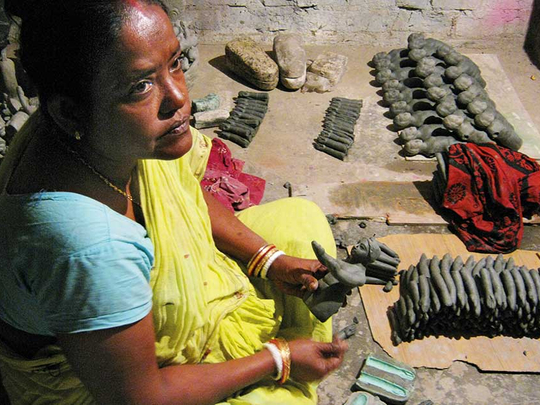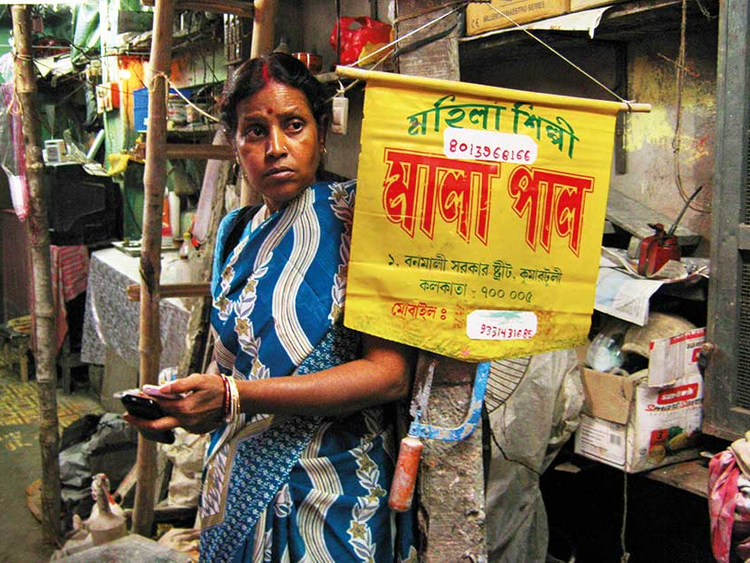
“This is where Sourav Ganguly sent the letter inviting me to Rojgerey Ginni,” says Mala Pal, gesturing around the tiny space that is her studio. Mala is one of the very few women artisans in Kumartuli, the traditional potters’ quarters in old Kolkata where those famous Durga idols are made.
She is referring to a popular reality TV show hosted by former Indian cricketer Saurav Ganguly in which she had featured as a guest.
It’s February 14, popularly celebrated as Valentine’s Day, but in Kumartuli, the day is being used to focus on a marginal community — women idolmakers. In this historic area of Kolkata, potters have for generations created jaw-dropping idols of deities for Durga Puja, and other religious festivals of West Bengal. In its winding, narrow lanes resides an artistic community that carries on a centuries-old tradition. Some potters’ families can trace their roots back to when the city was founded in 1757. Kumartuli is one of the many settlements which mushroomed here following the British colonisation of Bengal and the creation of Kolkata, when workers in various industries were allocated quarters according to the kind of work they did. For example, in Bengali “kumar” means “to sculpt or shape” and “tuli” means “place”. There are nearly 450 workshops in the area being run by families who have been in the profession for generations. They create close to 4,000 sets of Durga idols every year for the biggest festival in West Bengal. Some of these are shipped abroad to about 90 countries for religious events around the world.
The area may be churning out idols every month but Kolkata’s celebrated potters’ colony is still very much a male bastion.
A handful of women have been challenging this ancient monopoly, breathing life into wet clay to create a deity they call their own, a warrior woman who is their mascot. In February, women idolmakers organised a photo walk around the area, introducing people to their studios and work.
The event was part of One Billion Rising, a global movement initiated by feminist and author of The Vagina Monologues, Eve Ensler. It is considered to be one of the biggest mass action campaign to end violence against women in human history. The campaign, launched on Valentine’s Day in 2012, began as a call to action based on the staggering statistic that one in three women on the planet will be beaten or raped during her lifetime. The Kumartuli event was conceptualised by Green Tara Initiative Charitable Trust and is part of an ongoing process by Kolkata-based Participatory Publishing Praxis which will bring the women artists of Kumartuli together to create a book and in the process address key issues which is affecting them and the community at large.
It is perhaps ironic that most idols (at least the popular ones) created in Kuamrtuli are that of Hindu deities and yet the craft continues to be dominated by male artists. There are about a handful of women artists who are trying to change the status quo.
As we walk around the narrow lanes with Mala, cautiously avoiding brushing against the many works in progress, the issues and obstacles faced by the women emerge — sceptical customers, unsupportive family members, household work and children, and fellow male artists who do not take them seriously. One artist mentioned that some of her father’s crew members left as they could not accept orders from a woman.
Most women artists do not have their own studios. Some stick to making only smaller figurines as they do not take time or require space to craft. We come across Alpana Pal busy creating rows and rows of small idols “These are for the Marwaris. They have a puja around Holi [a Hindu spring festival]. It is like our Sitala Puja.”
Alpana picked up the craft from her mother Geeta Rani Dinda when she was 14. “I work from home mostly. I do not have a kaarkhana [workshop]. Sansaar thekiye joto somoye baachey tokhon kaaj kori (I work in whatever time I have left after looking after the household).” Her son is in art college she says, learning film direction.
Around the corner, a small shack is stacked with glittering, intricate crowns, arm and leg bands. This is Parul Raeel’s work — she makes accessories for the idols, jewellery for their head, arms, legs and chest created with sequins, zari, beads and mirrors. Raeel moved to Kumartuli from Nadia after her marriage. It took her about three days to make a set of ornaments for Kali. “I don’t sit in the shop, or do any becha-kena (selling). My husband does all that.”
Next door, on the mud floor of a hut, Nivedita sticks carefully crafted pencil shavings on a textbook to create a bouquet of flowers. She is doing her art homework under the watchful eyes of her mother Shrabani Pal.
Shrabani creates small idols. “I picked up the skill from my shashurima (mother-in-law), Arati Pal. She has been doing this for the past 40 years. She came here from Shantipur after her marriage.” Shantipur is an area in Bengal famous for taant sarees legendary for their fine texture and lightness. “Her family had 7-8 taant looms. She was skilled at making taant sarees too.”
Forty-something Mala Pal is one woman artisan who has her own studio and hires her own labourers. Her miniature idols are much in demand in the diaspora in Dubai, Europe, Australia the US and Canada. She specialises in foldable Durga puja idols where the idols are detachable from the base and can be packed separately for shipping. Mala also makes clay jewellery that is also shipped abroad. She has won several state awards for her craftsmanship. She took over the reigns of the family business when her father — a potter — died in 1985. None of her elder brothers showed any interest in the family enterprise. She made her first idol in 1993 as a teenager. “This place had not a single woman working as an artist then.”
It’s been a rough road but now her business is making some money. Her daughter has been picking up the ropes as well. “She has gone for her tuition class. She will be giving her Madhyamik [high school] exams this year,” she says proudly. And yet, she continues to face scepticism from her male colleagues. “They feel I cannot handle big orders for pujo [festivals] as I am a woman”.
Her story is similar to that of China Pal, who too got into the profession following the death of her father — renowned idol-maker Hemanta Pal — in 1994. Like Mala, China has received a state award — the Rajyapal Puroshkar. Like Mala, China’s brothers were not interested in continuing the family tradition preferring less strenuous jobs with better pay. So China, who was the youngest of Hemanta’s six children, took over her father’s studio. Today, she runs two studios and a team of 12 men. Among her works is the first transgender (or ardh-narishwar) idol of Shiva and Durga commissioned for Kolkata’s first transgender puja. She likes to keep to the traditional style of idol-making (which was her father’ style too) where all the five idols required for Durga Puja are set on a common backdrop.
As the sun sets and darkness engulfs the area, Mala and her small army of female artists bid goodbye — “we have to get back home to cook dinner”. Inside the studios and lanes, only men remained. Tomorrow, after the household chores, the real Durgas — the women artisans will be back crafting a hard-earned success, breaking traditions, persevering, and rising above stereotypes and patriarchy, carrying on the area’s 300-year-old tradition of craftsmanship.
Anuradha Sengupta is a writer based in Mumbai.














